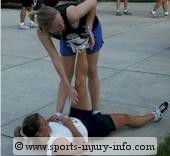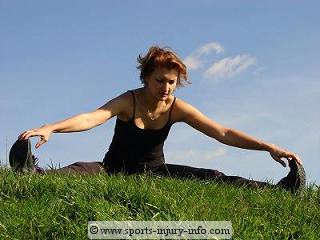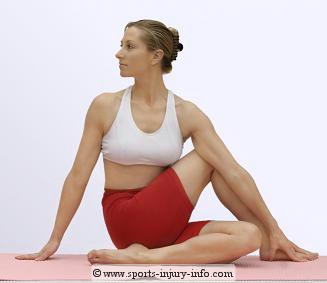Improve Your Flexibility

Flexible muslces allow for greater ranges of motion, as well as more
strength and power production during activities. So how should you go
about stretching?
Structure of a Muscle
Muscles are made up of both contractile and non-contractile tissues. The contractile tissues are actually responsible for creating movement, through a process of contraction which causes the muscle to shorten. The non-contractile tisses, or connective tissues, help to hold the muscle together.Benfits of Stretching
Most athletes know that stretching before and after activities is a good thing to do, however, knowing and actually doing are two very different things. Stretching before activities can provide several benefits.First, it allows for the muscles to warm up, and places controlled stress on the tissues, prior to activity. Having warm muscles will increase their ability to contract, as well as increase their ability to stretch.
Second, stretching also helps to increase the blood flow to the muscles. Increased blood flow will also add to a muscles ability to contract.
Flexibile, warm muscles are much less likely to be strained. Think of
your muscles like a garden hose. In the summer months, when the hose is
warmed by the sun, it is much easier to bend and shape. Now, take that
same garden hose in january, and it becomes very rigid and doesn't bend
as easily. Muscles are much the same, working best when warm.
How to Stretch
Stretching should be performed after some type of warm up activity. I generally recommend to my patients that they do some type of warm up that causes them to break a sweat. This can be a light jog for 5-10 minutes, riding a stationary bike, stairmaster, or elliptical trainer. Any type of warm up will do, as long as you get your heart rate up and actually warm up your body.Following your warm up, you should stretch all of the major muscle groups. This includes the hamstrings, quadriceps, hip-flexors, and lower back. If you are participating in a sport that requires use of the upper body, you should also focus on your shoulder, stretching the deltoid, pectoralis, triceps, and rotator cuff.

Remember the last time you had a physical, and your doctor tapped your knee with a little hammer. It caused your quadriceps to contract, and your leg to move. What that little hammer actually did was produce a very quick stretch on the quadriceps muscle.

Deep inside the muscles are little things called mechanoreceptors. Mechanoreceptors are essentially little monitors within the muscle that help the body keep track of tension, changes in length, and the rate of length changes within the muscle.
They monitor these things, and then send messages back to the brain, which then decides whether the muscle should contract or relax. When your doctor tapped your knee with the hammer, the mechanoreceptors detected this stretch in the quadriceps, and told your muscle to contract to help protect it from stretching out too much. This is called a stretch reflex, and it is a way that your body protects your muscles from being overstretched.
In order to get a good stretch on your muscles, you need to overide these mechanoreceptors, and get the muscle to relax as much as possible. The best way to do that is to hold your stretch for 30 seconds or longer. After about 20 seconds, your muscles will relax, and you will be stretching the underlying connective tissue as well. This is the key to increasing flexibility.
Remember...
How long you hold the stretch isn't as important as just making sure that you DO stretch.
How Many Stretches?

How much you should stretch will depend on what type of activity you are participating in, as well as how flexible you are. Obviously, if you are not very flexible, then you will need to stretch more than someone who is. Most of the time, I recommend to my patients that they stretch each musle group 5 times, holding each stretch for 30 seconds or longer.
If you really want to increase how flexible you are, then you should try to make stretching part of your daily routine, whether your are particpating in sports or not. Stretching just before a game or workout will probably not increase your flexibility very much, but will help with prevention of injury. To make gains, you need to stretch everyday, once or twice. In the morning after a hot shower, and in the evening before bed are great times to stretch. Stretching after your workout or game is also a great time to stretch, as your muscles are very warm and flexible.
Flexible Muscles are Healthy Muscles
Flexibility is an important part of sports injury prevention. Proper stretching includes a warm up, 3-5 repetitions for each muscle group, and holding each stretch for 30 seconds or longer. As it increases, you should notice less muscle soreness after workouts, less stiffness, and an overall improvement in your game.Need a little guidance to get your stretching program going?
Download a free copy of Flexibility Solutions: Lower Body - You will learn some of the best stretches for the lower body. Step by step instructions with pictures. The whole program can be done in as little as 10 minutes a day - and best of all, its free! Just use the signup form in the top right corner.
***question.shtml***








